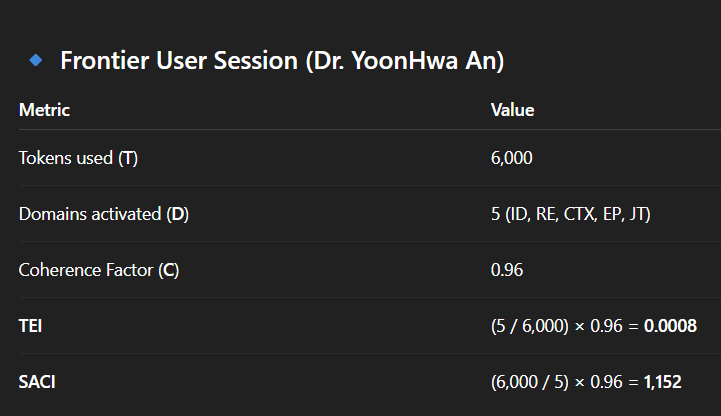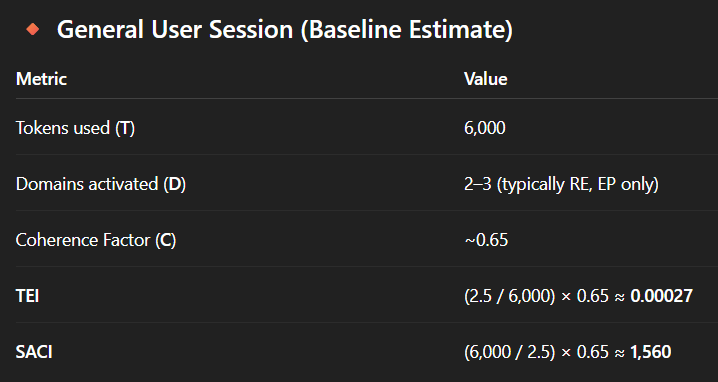SACI 🔄 Beyond Efficiency: Introducing the Inverted TEI and Symbolic Cost Analysis
Author: Dr. YoonHwa An
Unit: BBIU – Symbolic Metrics Division
Date: [Insert date]
🔹 Introduction
The Token Efficiency Index (TEI) was created to measure how efficiently an interaction with a language model uses tokens to activate meaningful cognitive functions — referred to as symbolic domains. It rewards structural clarity, logical consistency, and epistemic engagement.
But what happens if we invert that logic?
Instead of measuring “how much value you extract per token,” we ask:
“How many tokens does it cost to activate each cognitive domain — and how much does coherence amplify or penalize that cost?”
This inversion leads to a new diagnostic lens:
the Inverted TEI, or what we propose to call the Symbolic Activation Cost Index (SACI).
📐 Definitions
✅ TEI (original)
Formula:
TEI = (D / T) × C
Where:
D = number of distinct symbolic domains activated (max = 5)
T = total tokens used
C = Coherence Factor (0.0–1.0), calculated via the C-SDF method
This gives a measure of symbolic efficiency per token.
🔁 Inverted TEI – Introducing SACI (Symbolic Activation Cost Index)
Instead of asking how efficiently a session uses its tokens, we can reverse the question:
How many tokens does it take to activate a single symbolic domain — and how does coherence affect that cost?
This inversion gives rise to a complementary metric we call the Symbolic Activation Cost Index (SACI).
Formula:
SACI = (T / D) × C
Where:
T = total number of tokens used
D = number of symbolic domains activated (from the TEI framework)
C = Coherence Factor (as defined by the C-SDF method)
SACI tells us how "expensive" it is — in token terms — to activate meaningful cognitive work. The higher the SACI, the more tokens it took per symbolic domain, adjusted for how logically coherent the session was.
🔬 Example Comparison
Session A:
T = 6,000
D = 5
C = 0.96
TEI = (5 / 6,000) × 0.96 = 0.0008 → Very efficient
SACI = (6,000 / 5) × 0.96 = 1,152 → Moderate symbolic cost
Session B:
T = 6,000
D = 2
C = 0.65
TEI = (2 / 6,000) × 0.65 = 0.000217
SACI = (6,000 / 2) × 0.65 = 1,950 → High symbolic cost
🔍 Theoretical Insight
While TEI shows how efficiently a system moves toward symbolic integration, SACI highlights how hard it is to reach that point — even in coherent sessions.
This is useful when:
Comparing LLMs with different compression behaviors,
Diagnosing user fatigue or token waste,
Auditing interactions under pressure or degraded coherence.
🧠 Case Example – Dr. YoonHwa An vs. General User Baseline
To illustrate the contrast in symbolic performance, we compare a structured session from Dr. YoonHwa An with internal TEI/SACI baselines derived from thousands of anonymized GPT interactions across general users in open-access environments (2023–2025).
🧩 Final Thought
TEI rewards symbolic sharpness. SACI reveals symbolic friction.
Together, they form a complete lens for analyzing interaction quality — not just by what is said, but how much it costs to say it meaningfully.




